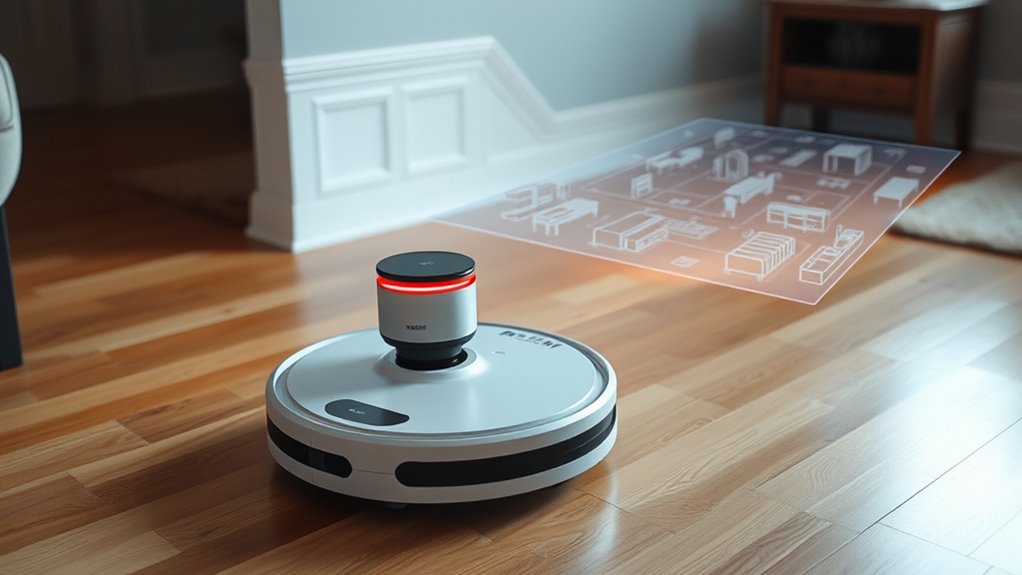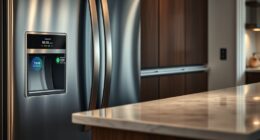If you want a robot vacuum with precise mapping and reliable performance in dark or complex spaces, LiDAR is the better choice, though it’s more expensive. VSLAM uses cameras and is budget-friendly, but it can struggle in low-light environments and with intricate layouts. Understanding these differences helps you pick the right tech for your home. Keep exploring how these features impact cleaning, and you’ll find the perfect fit.
Key Takeaways
- LiDAR provides highly accurate 3D maps, performs well in low-light conditions, and is ideal for large or complex homes.
- VSLAM relies on visual cues from cameras, which require sufficient lighting and are less effective in dark or cluttered environments.
- LiDAR systems tend to be more expensive but offer faster, more reliable navigation and obstacle detection.
- VSLAM is more budget-friendly, suitable for small to medium homes, but may struggle with accuracy and efficiency in complex spaces.
- Future advancements in sensors and AI are enhancing both technologies’ obstacle detection and navigation capabilities.
Understanding the Core Technologies: Lidar and Vslam
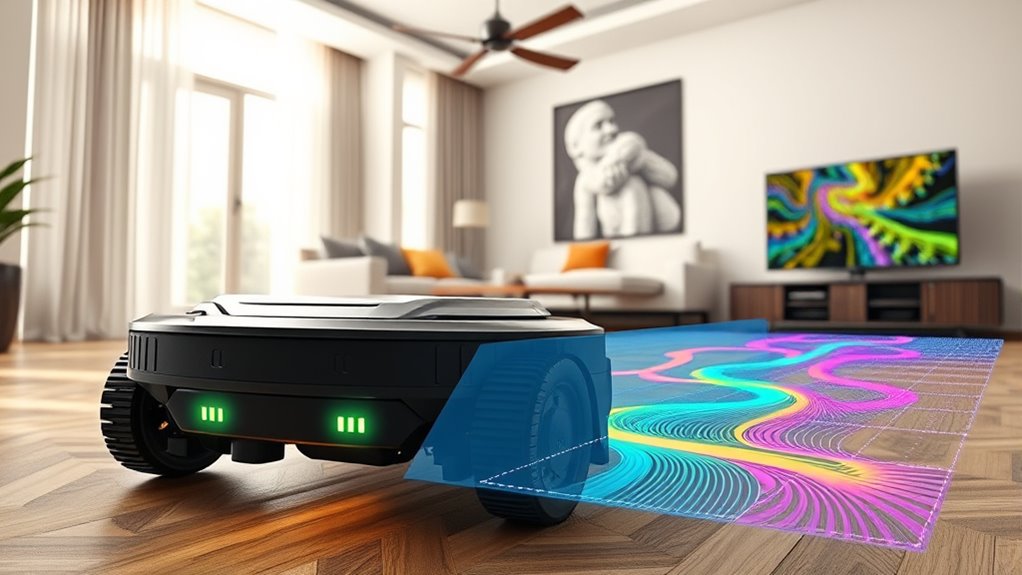
To understand how robot vacuums navigate, grasping the core technologies behind their systems: LiDAR and VSLAM, is essential. LiDAR uses laser pulses to measure distances by calculating the time it takes for light to reflect back, creating detailed 3D maps of your environment. It operates independently of lighting conditions but can be affected by water, fog, or certain surfaces. Active sensing by emitting laser pulses and measuring reflection time enables precise environmental mapping. Additionally, LiDAR systems often incorporate laser beam steering techniques to scan environments more efficiently. The resolution of LiDAR sensors determines how accurately they can detect small objects and details in the environment, impacting navigation precision. VSLAM, on the other hand, relies on cameras to track visual features and build maps in real time. This technology processes complex algorithms to detect and follow features, making it adaptable indoors and outdoors. While LiDAR offers high-precision measurements, VSLAM provides greater flexibility in varied lighting. Both systems require integration with other sensors like GNSS or IMU for accurate navigation.
Comparing Mapping Precision and Accuracy
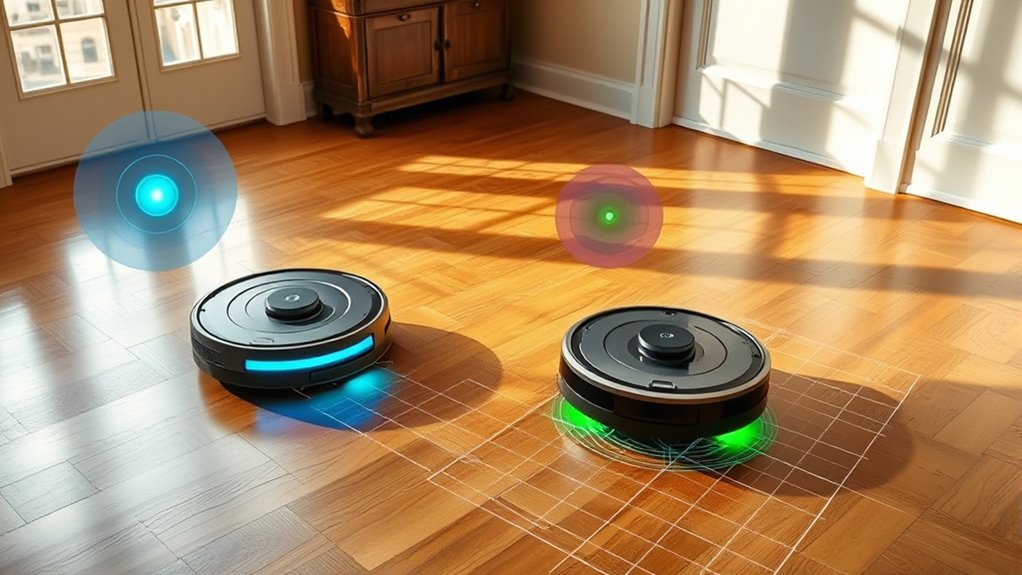
When comparing the mapping capabilities of LiDAR and vSLAM, it’s clear that each technology offers different levels of precision and accuracy. LiDAR produces highly detailed and consistent 3D maps by measuring distances with laser pulses, ensuring accurate depth and spatial details even in complex or cluttered environments. It remains reliable in low-light or dark areas, maintaining mapping accuracy where vSLAM’s visual reliance falters. VSLAM creates maps from camera images, which can be less precise due to dependence on lighting and image quality. While vSLAM captures visual features like textures and decorations better, it struggles with environmental challenges such as reflective surfaces or poor illumination. Overall, LiDAR provides superior metric accuracy, especially in varied lighting conditions and large, intricate layouts. LiDAR’s precision is also beneficial for detailed obstacle detection and avoidance, making it a preferred choice for thorough navigation. Additionally, mapping consistency is often higher with LiDAR, reducing the need for frequent recalibration or manual corrections. The ability to maintain accuracy over time also contributes to LiDAR’s reliability in long-term applications.
Performance in Different Lighting Environments
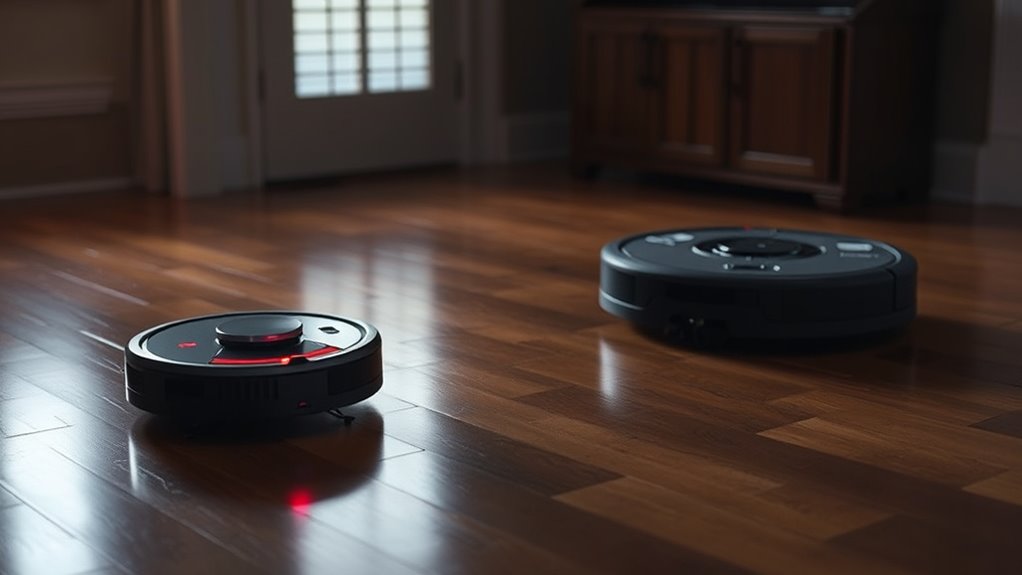
Lighting conditions considerably influence how well robot vacuums perform their mapping and navigation tasks. LiDAR uses infrared lasers that operate independently of ambient light, allowing smooth functioning even in complete darkness. In contrast, vSLAM depends on optical cameras that require consistent, sufficient lighting to capture visual cues accurately. Low-light or dark environments cause vSLAM’s performance in visual data processing to degrade, resulting in poor localization and mapping. Some vSLAM vacuums include LED headlights, but these often aren’t enough in fully dark settings. LiDAR’s immunity to lighting conditions guarantees reliable operation regardless of time or light presence. It maintains consistent mapping speed, obstacle detection, and navigation accuracy, while vSLAM struggles without proper lighting, impacting overall efficiency and safety. Additionally, the effectiveness of vSLAM can be significantly affected by ambient lighting levels, which directly impacts the quality of visual data used for navigation.
Cost Implications and Hardware Complexity
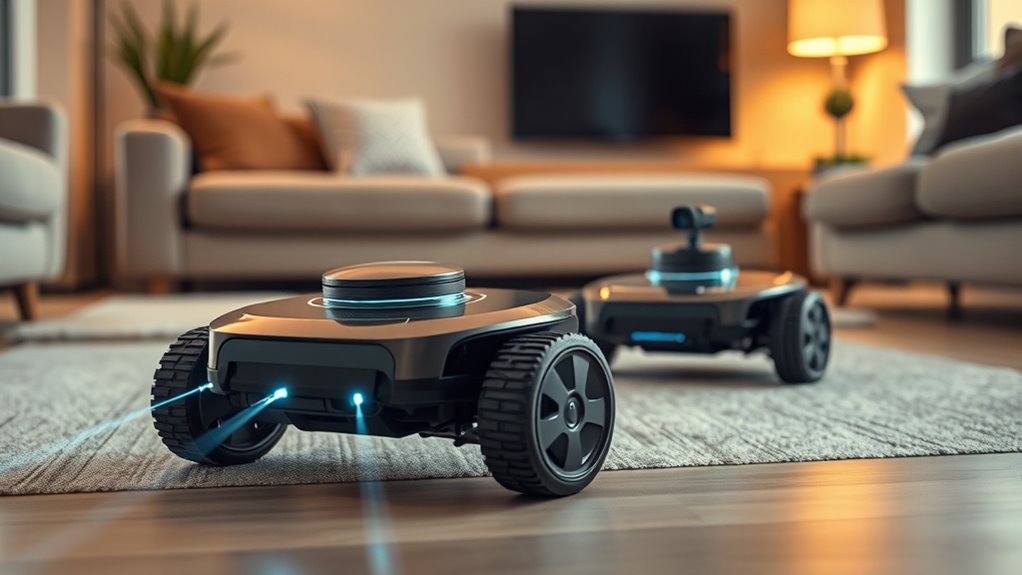
You’ll notice that robots with LiDAR sensors tend to cost more due to their complex, precision-engineered hardware and spinning or solid-state modules. In contrast, vSLAM systems use cheaper cameras and simpler components, keeping prices lower for consumers. Ultimately, these hardware choices impact affordability, balancing navigation accuracy against overall cost. Additionally, the cost-effective nature of vSLAM makes it a popular choice for budget-conscious consumers seeking reliable cleaning performance. Incorporating sensor technology can further influence the cost and capabilities of these robotic systems.
Hardware Cost Differences
LiDAR systems typically cost substantially more than camera-only solutions due to their complex laser hardware and precise manufacturing requirements. The intricate laser emitters, photodetectors, and scanning mechanisms drive up production costs. Supporting electronics and power management systems further increase the overall hardware expense. High-end robot vacuums mainly use LiDAR because of its superior mapping accuracy, reflected in their premium prices. In contrast, vSLAM relies on affordable CMOS cameras and low-cost IMUs. The physical hardware in vSLAM is simpler, reducing repair and maintenance costs. Additionally, LiDAR units demand meticulous calibration and integration, adding to their complexity. Conversely, camera-based systems benefit from easier calibration and fewer hardware components, keeping costs lower across the board. Hardware complexity also influences the overall reliability and ease of deployment for these navigation systems.
Sensor Complexity & Price
Have you ever wondered why some robot vacuums cost more? It’s mainly due to sensor complexity and hardware demands. LiDAR systems need precise laser emitters, receivers, and rotating or fixed assemblies, making them mechanically intricate and costly. They also generate large point-cloud data, requiring powerful processors and advanced filtering. In contrast, vSLAM relies on cameras and embedded image processors, reducing mechanical parts and overall complexity. However, cameras and image processing units increase software and computational demands, especially with higher resolutions. Sensor fusion with IMUs adds further calibration challenges for both, but LiDAR’s geometric data is simpler to interpret. Additionally, sensor integration complexities can impact the manufacturing and maintenance costs of these navigation systems. Moreover, the hardware complexity of LiDAR often results in higher production costs compared to camera-based systems.
Affordability for Consumers
The complexity of navigation hardware considerably influences the overall cost of robot vacuums, shaping what’s available to consumers. LiDAR-based models tend to be more expensive due to advanced laser technology and specialized components, often exceeding $400. In contrast, vSLAM vacuums use camera systems that are cheaper, making them more accessible for budget-conscious buyers. Bitcoin IRA strategies highlight how technology choices can impact long-term value and growth potential in investments. Additionally, the Relationships – Personality Test knowledge underscores how different hardware choices can influence user perceptions of reliability and performance.
- LiDAR models are generally in premium or mid-range prices, while vSLAM options are more affordable
- Additional hardware like processors and AI features increase LiDAR’s costs
- Camera modules used in vSLAM benefit from economies of scale, lowering prices
- Manufacturing complexities and calibration add to LiDAR’s higher price tag
Navigation Efficiency and Cleaning Strategies
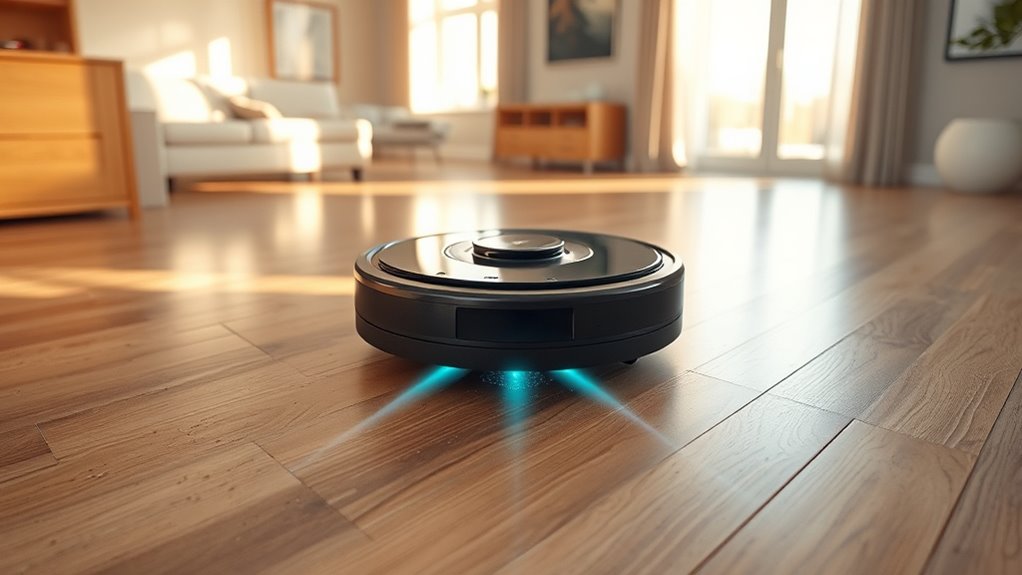
Your robot’s route planning determines how efficiently it covers your space, with precise navigation reducing missed spots and overlap. Obstacle detection varies between laser-based systems and camera-based ones, affecting how well your vacuum avoids furniture and hazards. Cleaning speed can fluctuate based on the navigation method, impacting how quickly and thoroughly your home gets cleaned. Using Bluetooth connectivity can also influence the responsiveness and control of your device during operation. Implementing navigation algorithms that adapt to your home layout can further enhance cleaning performance and reduce the need for manual intervention.
Route Planning Precision
How precisely a robot vacuum plans its route greatly impacts its cleaning efficiency and effectiveness. With LiDAR, you get laser pulses that create highly detailed, accurate maps, ensuring reliable localization even in complex spaces. It quickly recalculates routes and partitions areas systematically, covering large spaces efficiently. In contrast, vSLAM uses visual features from cameras, which work well in well-lit environments but struggle in dim or changing light, reducing mapping accuracy. Additionally, LiDAR technology is frequently used in Honda Tuning to optimize vehicle performance through precise sensor data. LiDAR’s high-resolution sensing also makes it suitable for navigating dynamic environments with moving obstacles.
Obstacle Detection Methods
Obstacle detection methods directly influence how efficiently your robot vacuum navigates and cleans your space. LiDAR scans the environment with laser beams, creating a precise 360-degree map that detects both large and small objects, even in darkness. VSLAM uses cameras to recognize shapes, textures, and colors, allowing semantic understanding but depends on lighting conditions. Sensor fusion combines multiple sensors for redundancy, improving obstacle detection reliability. The table below summarizes the key differences:
| Method | Strengths | Limitations |
|---|---|---|
| LiDAR | Accurate, works in darkness | Struggles with transparent surfaces |
| VSLAM | Recognizes objects, semantic mapping | Sensitive to lighting and occlusions |
| Sensor Fusion | Robust, compensates weaknesses | More complex setup |
These methods enhance navigation efficiency by reducing collisions and enabling systematic cleaning. Additionally, advancements in sensor technology continue to improve the overall performance of robot vacuums. A deeper understanding of navigation algorithms can further optimize cleaning routes and adapt to complex environments.
Cleaning Speed Variability
LiDAR-based robot vacuums typically complete their cleaning tasks more quickly than vSLAM models, thanks to their faster mapping and route planning capabilities. They create detailed maps rapidly, often finishing the initial map in one cleaning session, while vSLAM may need two or three runs. Their precise route planning avoids redundant paths, boosting efficiency. Additionally, LiDAR vacuums perform better in complex environments and low-light conditions, maintaining consistent speed. They clean in straight lines for exhaustive coverage and optimize routes to minimize unnecessary maneuvers. This results in a cleaning speed that’s generally 20-30% faster than camera-based models, especially in larger or more intricate spaces. Furthermore, compact designs contribute to their quick setup and mobility, enhancing overall cleaning efficiency. The ability to adapt to different environments effectively is a key factor in their navigation efficiency.
Suitability for Various Home Layouts and Sizes
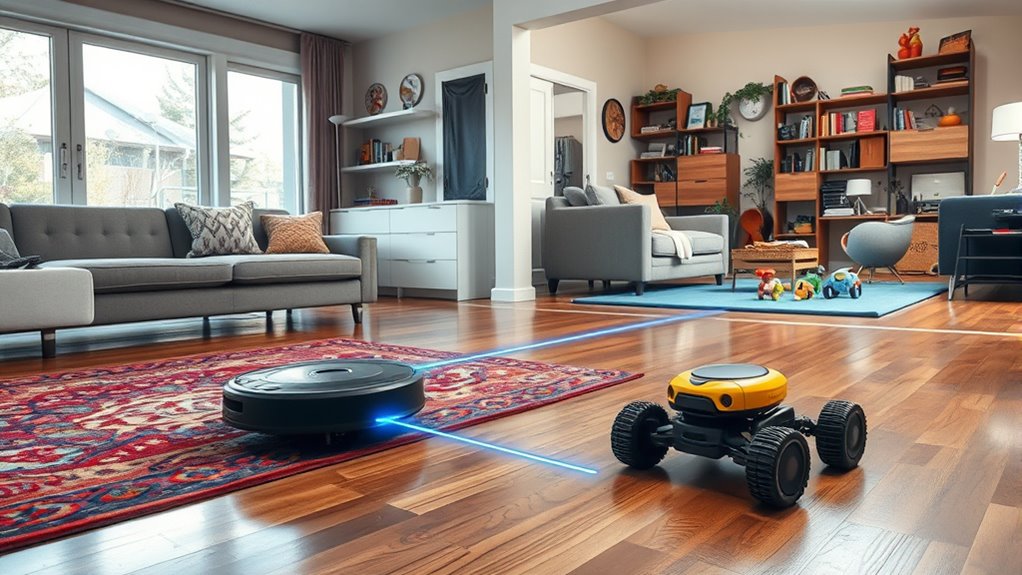
Choosing the right robot vacuum depends heavily on your home’s layout and size. LiDAR excels in large homes by quickly generating accurate maps and planning efficient routes, ensuring no area is missed. It handles multi-room environments and complex layouts with ease, making it ideal for bigger spaces. Its fast navigation and battery efficiency allow thorough cleaning before recharging. In contrast, vSLAM works well in smaller or open-plan homes, especially with good lighting, but struggles with extensive spaces due to slower mapping. Homes with multiple floors benefit from LiDAR’s ability to store and switch between detailed maps seamlessly. Meanwhile, vSLAM relies on visual landmarks, which can be less reliable in poorly lit or complex environments. Overall, LiDAR is better suited for larger, more intricate homes, while vSLAM suits smaller, simpler spaces. Additionally, Paint Sprayer Reviews & Buying Guides insights reveal that choosing the appropriate navigation technology can significantly impact cleaning efficiency and coverage.
Obstacle Detection and Avoidance Capabilities
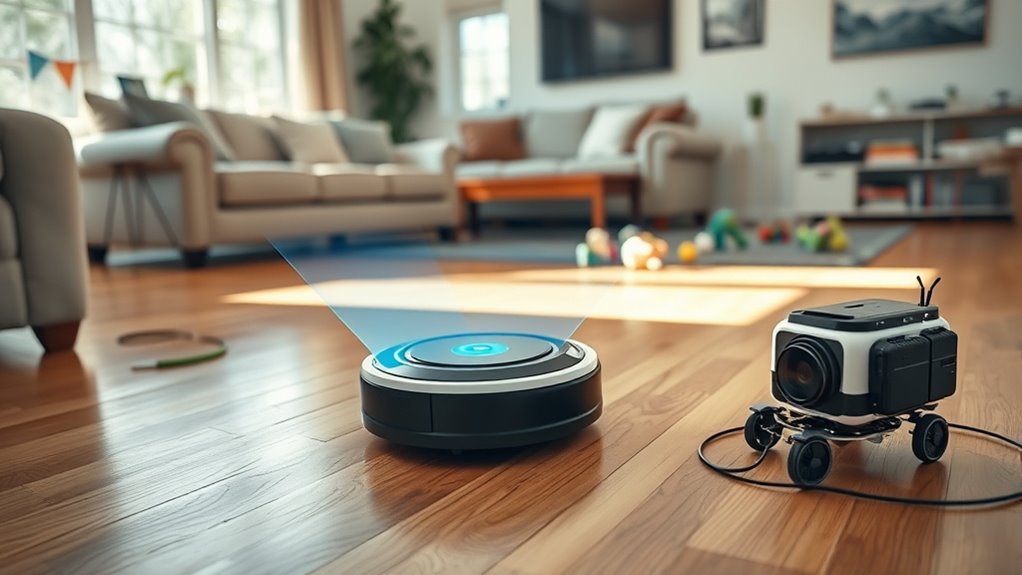
When it comes to maneuvering your home efficiently, the ability of a robot vacuum to detect and avoid obstacles plays a vital role. LiDAR uses laser pulses to create detailed maps, accurately detecting small objects like socks and uneven surfaces. It measures distances directly, enabling faster, more reliable obstacle avoidance. In contrast, vSLAM relies on camera visuals, making it sensitive to lighting and less effective in dark or low-light areas. While vSLAM performs well in well-lit environments, it may miss or misclassify objects in dim settings. Combining LiDAR with cameras can improve obstacle perception by adding visual context.
- LiDAR detects small objects precisely
- vSLAM is affected by lighting conditions
- LiDAR allows smoother navigation
- vSLAM may struggle with fast-moving obstacles
Practical Considerations for Homeowners

Understanding the practical aspects of robot vacuum navigation can help you select the right model for your home. If your space has low lighting or dark corners, a LiDAR-based vacuum is ideal because it doesn’t rely on ambient light and maintains consistent navigation. For homes with large, complex layouts or many obstacles, LiDAR provides faster, more reliable coverage, reducing missed spots. On a budget, vSLAM models are more affordable and work well in well-lit, simple environments, especially where visual cues like furniture or decorations help the vacuum recognize its surroundings. Consider your home’s size, lighting conditions, and clutter levels. LiDAR offers efficiency and reliability, but vSLAM can be a cost-effective choice for straightforward cleaning needs.
Future Trends in Robot Vacuum Navigation
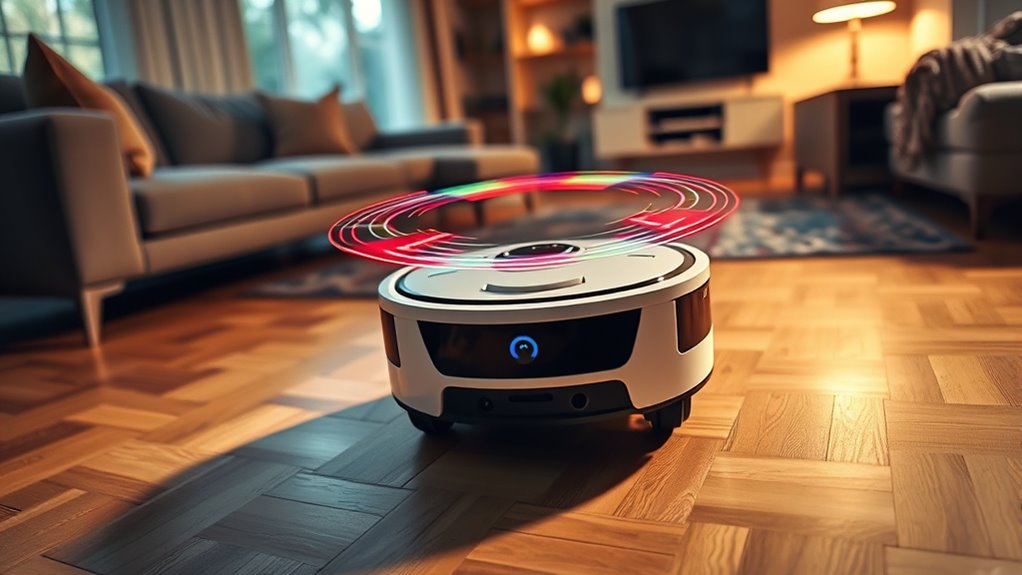
Advancements in AI and machine learning are transforming how robot vacuums navigate your home. These technologies help your robot understand complex environments, optimize cleaning paths, and adapt to changes in real time. AI enables differentiation of floor types, furniture layouts, and dirt-prone zones, adjusting cleaning modes automatically. Machine learning enhances obstacle recognition, learning from each cycle to avoid future issues. Expect smarter scheduling and predictive maintenance based on your usage patterns. Next-gen sensors like 3D vision and ToF improve mapping and obstacle detection. Foldable LiDAR systems boost navigation flexibility, while multi-layer sensors identify small objects such as wires or toys. Combining LiDAR with visual SLAM increases indoor localization accuracy, ensuring seamless progressions across different floor types and thresholds.
- Smarter cleaning schedules and maintenance alerts
- Enhanced obstacle recognition and avoidance
- Advanced sensors for precise mapping
- Greater home automation integration
Frequently Asked Questions
How Do Lidar and Vslam Handle Moving Obstacles During Cleaning?
You notice that LiDAR detects moving obstacles quickly and accurately because it emits laser pulses and creates real-time maps, allowing smooth rerouting. VSLAM relies on camera images, so it may lag in response, especially with fast or unpredictable obstacles. In low light, VSLAM struggles, while LiDAR maintains consistent obstacle detection. Overall, LiDAR handles moving obstacles more reliably, ensuring your robot cleans efficiently without collisions.
Can Robot Vacuums Switch Between Lidar and Vslam Modes Automatically?
Imagine your robot vacuum as a sci-fi drone, effortlessly switching between navigation modes. Currently, most vacuums don’t automatically switch between LiDAR and vSLAM. They’re designed to use one primary system, with some models combining both but not toggling modes on the fly. Technical challenges like data integration and power consumption prevent seamless switching. So, you usually have to choose or manually switch modes, but automatic switching isn’t common yet.
What Maintenance Is Required for Lidar Versus Camera-Based Navigation Systems?
You need to clean the LiDAR sensor’s optical window regularly with a dry, lint-free cloth and check the rotation mechanism to prevent obstructions. For camera-based systems, wipe the lens gently and frequently to avoid smudges or dirt that can impair navigation. Both require powering off the robot before maintenance, but LiDAR demands less frequent care, mainly focusing on keeping the optical window clear, while cameras need more regular cleaning and calibration.
How Do Environmental Factors Like Dust or Pet Hair Affect Sensor Performance?
Like a painter’s canvas smeared with dust, environmental factors can blur your sensor’s clarity. Dust and pet hair cling to lenses and LiDAR windows, scattering laser pulses and obscuring vision. This causes inaccurate mapping, missed obstacles, or false detections. You must regularly clean sensors, and consider protective measures. Using sensor fusion or self-cleaning tech helps mitigate these issues, ensuring your robot navigates smoothly despite environmental chaos.
Are There Hybrid Navigation Systems Combining Lidar and Vslam Advantages?
Yes, there are hybrid navigation systems that combine LiDAR and vSLAM to maximize benefits. These systems use LiDAR’s quick, accurate laser scans for mapping and vSLAM’s visual data for obstacle recognition and detailed environment understanding. You’ll get faster, more reliable cleaning, better obstacle detection, and adaptive route planning. While they’re more complex and costly, they offer improved performance across various lighting and layout conditions, making your cleaning smarter and more efficient.
Conclusion
Choosing between lidar and VSLAM is like picking the right compass for your home’s maze—both guide you well, but each has its quirks. Lidar offers precision like a lighthouse, while VSLAM navigates with the agility of a seasoned explorer. Consider your home’s layout, budget, and cleaning needs to find your perfect match. With the right technology, your robot vacuum becomes a trusty ship sailing smoothly through your home’s waters.
